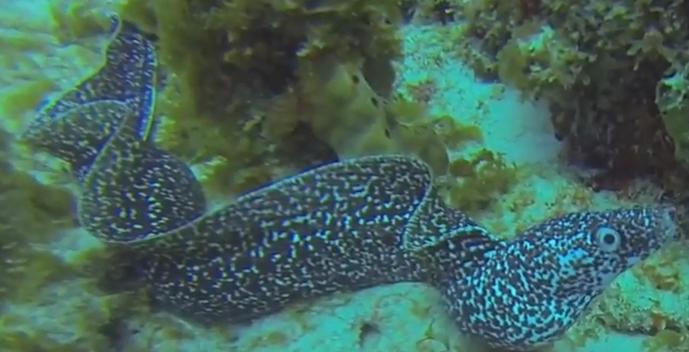



Gymnothorax moringa
| Ecological Descriptors |
||||
| Habitat | Size (cm) | Diet | Behaviour | Sex |
| Be, Co, R | 90 | Pisc, Cru | I | F |
Description:
Body long and snake-like, without pectoral or ventral fins; dorsal, tail and anal fins form a single, long, continuous fin that begins behind the head, encircles the tail and extends midway down the belly. Body scale-less and coated with a clear, protective mucus layer. Body heavy to medium, ground color white to yellow, speckled with dark spots and blotches.
Ecology
Inhabits shallow reefs, coral rubble and seagrass beds, down to 12 meters. Hide during the day in recesses; heads often extend from openings. It is active during the day, sometimes together with other predators. It feeds on fish, crustaceans and octopus It is usually seen with its head protruding from a hole and the rest of its body concealed, but forages in open at night. Constantly open and close mouth in order to move water through their gills for respiration.
Life Cycle
Oviparous, meaning their eggs hatch outside of the body. No specific mating season, dependent on sufficient food availability and a suitable habitat. The female will lay up to 10,000 eggs, distributed in a hidden area away from predators. She then produces a scent that attracts the males to come fertilize the eggs with their sperm. It takes 30-45 days for the eggs to hatch but this may be shorter if water temperatures are warmer. The majority of baby eels that hatches may be eaten by other predators but a few survive to adulthood. At three years they can begin to mate and reproduce.
Body long and snake-like, without pectoral or ventral fins; dorsal, tail and anal fins form a single, long, continuous fin that begins behind the head, encircles the tail and extends midway down the belly. Body scale-less and coated with a clear, protective mucus layer. Body heavy to medium, ground color white to yellow, speckled with dark spots and blotches.
Ecology
Inhabits shallow reefs, coral rubble and seagrass beds, down to 12 meters. Hide during the day in recesses; heads often extend from openings. It is active during the day, sometimes together with other predators. It feeds on fish, crustaceans and octopus It is usually seen with its head protruding from a hole and the rest of its body concealed, but forages in open at night. Constantly open and close mouth in order to move water through their gills for respiration.
Life Cycle
Oviparous, meaning their eggs hatch outside of the body. No specific mating season, dependent on sufficient food availability and a suitable habitat. The female will lay up to 10,000 eggs, distributed in a hidden area away from predators. She then produces a scent that attracts the males to come fertilize the eggs with their sperm. It takes 30-45 days for the eggs to hatch but this may be shorter if water temperatures are warmer. The majority of baby eels that hatches may be eaten by other predators but a few survive to adulthood. At three years they can begin to mate and reproduce.
Spotted Moray Eel

Spotted Moray Eel

62


168


